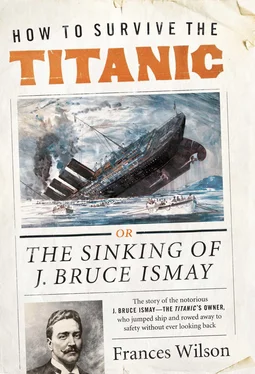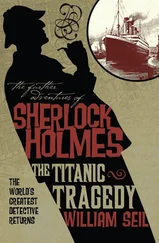The chandeliered East Room was cleared of its gilt and brocade furniture and a walnut conference table was placed in the centre. Ismay, in a new blue suit with a black scarf running through the high collar, was the first to push through the crowds outside and his party sat and waited. Soon after 10 a.m. the doors opened to allow in reporters and a great tide of spectators, most of them well-heeled women in plumed hats. The notorious figure they had all come to see was fiddling nervously with his moustache and shirt cuffs. One journalist described Ismay as looking ‘distinctly oriental’, another thought he looked suspiciously ‘German’, and a third said his appearance was that of a ‘cultivated Englishman’, which was not intended as a compliment. But the general impression Ismay gave to the crowd whose gaze had fixed itself upon him was of a man who, as a fourth reporter put it, lived ‘a life of ease rather than one of strength, as if he were accustomed to having his own way because it is given him rather than because he wins it’. Meanwhile in London, a crowd of 5,000 had formed around St Paul’s Cathedral where a memorial service for the victims of the wreck was taking place.
At 10.30 Senators Smith and Newlands arrived with their advisor, General Uhler of the Commerce Department’s steamboat inspection service. The room fell silent, and after Smith’s brief introduction to the proceedings, the cross-examination of Ismay began.
In a voice scarcely above a whisper, he gave his name, his age ( fifty on the 12th of December ) and his occupation ( shipowner and Managing Director of the White Star Line ). Asked whether he was ‘officially designated to make the trial trip of the Titanic Ismay replied that he had been a voluntary passenger. ‘Will you kindly tell the committee,’ asked Smith, ‘the circumstances surrounding your voyage, and, as succinctly as possible, beginning with your going aboard the vessel at Liverpool, your place on the ship on the voyage, together with any circumstances you feel would be helpful to us in this inquiry?’
Ismay did not immediately answer the question. Instead, he gave a pre-rehearsed statement, doubtless drafted by Franklin:
In the first place, I would like to express my sincere grief at this deplorable catastrophe. I understand that you gentlemen have been appointed as a committee of the Senate to inquire into the circumstances. So far as we are concerned, we welcome it. We court the fullest inquiry. We have nothing to conceal; nothing to hide. The ship was built in Belfast. She was the latest thing in the art of shipbuilding; absolutely no money was spared in her construction. She was not built by contract. She was simply built on a commission.
It was the wrong time to promote the qualities of the Titanic, but Ismay was not used to talking in any other way. She left Belfast, as far as I remember — I am not absolutely certain about these dates — I think it was on the 1st of April. She underwent her trials, which were entirely satisfactory. She then proceeded to Southampton; arriving there on Wednesday. Smith, who now understood that he had made an error in not knowing from which port the Titanic had left England, asked Ismay to describe the trials. I was not present, Ismay said, and instead he gave a breakdown of the ship’s progress on her first few days. She arrived at Southampton on Wednesday, the 3rd I think, and sailed on Wednesday the 10th. She left Southampton at 12 o’clock. She arrived in Cherbourg that evening, having run over at sixty-eight revolutions. We left Cherbourg and proceeded to Queenstown. We arrived there, I think, about midday on Thursday. We ran from Cherbourg to Queenstown at seventy revolutions. After embarking the mails and passengers, we proceeded at seventy revolutions. I am not absolutely clear what the first day’s run was, whether it was 465 or 484 miles. The second day the number of revolutions was increased. I think the number of revolutions on the second day was about seventy-two. I think we ran on the second day 519 miles. The third day the revolutions were increased to seventy-five, and I think we ran 546 or 549 miles. The weather during this time was absolutely fine, with the exception, I think, of about 10 minutes’ fog one evening. The ship sank, I am told, at 2.20. That, sir, is all I can tell you.
Ismay paused, and then remembered that he did have more to say. He had omitted the most important point. I understand it has been stated that the ship was going at full speed. The ship never had been at full speed. The full speed of the ship is seventy-eight revolutions. She had not all her boilers on. None of the single-ended boilers were on. It was our intention, if we had fine weather, on Monday afternoon or Tuesday, to drive the ship at full speed. That, owing to the unfortunate catastrophe, never eventuated. Smith did not ask about the meeting in which the decision to drive the ship at full speed was made. What he understood from Ismay’s statement is that the Titanic was instructed to go steadily faster, and that although Ismay was only a voluntary passenger, it had also been his — our — intention to drive the ship at full speed the following week. Who, Smith wondered, controlled the ship: Mr Ismay or Captain Smith?
Asked to describe his actions after the ‘impact or collision’, Ismay repeated the account he had given to reporters the night before of how he had been drifting off to sleep, had got out of bed, put on his coat over his pyjamas, and gone to the bridge where he was informed by Captain Smith that they had struck ice. Nothing more was said between the two men. Ismay then walked along the starboard side of the ship, and told one of the officers to begin preparing the boats. He assisted, the best I could in helping to load the women and children. I stood upon the deck practically until I left the ship in the starboard collapsible boat, which was the last boat to leave the ship, so far as I know. More than that I do not know. A murmur of surprise went round the room; according to a number of witnesses whose comments had appeared in newspaper reports, Ismay had left in the first boat. Smith questioned him about the position of his stateroom and then returned to the purpose of his presence on the Titanic. Was it to view the ship in action, or did he have business in New York? I had no business to bring me to New York at all. I simply came in the natural course of events, as one is apt to do, in the case of a new ship, to see how she works, and with the idea of seeing how we could improve on her for the next ship we are building. The irony of his answer cannot have been missed. It appeared that Ismay was the only person on the voyage who successfully achieved what he set out to do. 3
Had he, Smith asked, ‘consulted with the Captain about the movement of the ship?’ Never, Ismay replied. Did the Captain consult with Ismay about the movement of the ship? Never, he repeated, and then demurred. Perhaps I am wrong in saying that. I should like to say this: I do not know that it was quite a matter of consulting him about it or his consulting me about it, but what we had arranged to do was that we would not attempt to arrive in New York at the lightship before 5 o’clock on Wednesday morning. Ismay needed to put paid to the suggestion that he had been pressurising the Captain to make a record crossing by insisting that there was nothing to be gained by docking in New York any earlier than planned; it would be inconvenient to the passengers who were expecting to be picked up on Wednesday morning to arrive instead on Tuesday night and that kind of nuisance would not reflect well on the White Star Line. In which case, asked Smith, why were the ship’s revolutions increased during the journey? Because, replied Ismay, the Titanic being a new ship, we were gradually working her up. When you bring out a new ship you naturally do not start her running at full speed until you get everything working smoothly and satisfactorily down below. Ismay said he had nothing to do with the ‘movement of the ship’, but he continued to refer to himself and the Captain as we; they were a team.
Читать дальше












